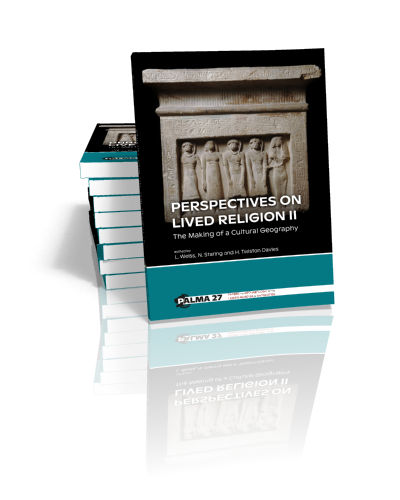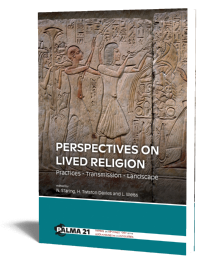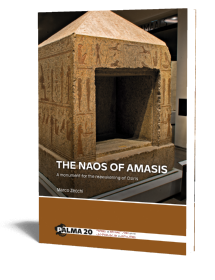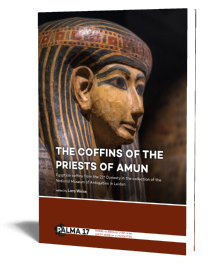Perspectives on Lived Religion II
The Making of a Cultural Geography
Edited by Lara Weiss, Nico Staring, Huw Twiston Davies | 2022

Perspectives on Lived Religion II
The Making of a Cultural Geography
Edited by Lara Weiss, Nico Staring, Huw Twiston Davies | 2022
Paperback ISBN: 9789464261196 | Hardback ISBN: 9789464261202 | Imprint: Sidestone Press | Format: 210x280mm | 164 pp. | Papers on Archaeology of the Leiden Museum of Antiquities 27 | Series: PALMA | Language: English | 28 illus. (bw) | 31 illus. (fc) | Keywords: religion; transmission; landscape; archaeology; ancient Egypt; art history | download cover | DOI: 10.59641/e4i0177g
Read online 809 times
- Digital & Online access
-
Buy via Sidestone (EU & UK)
-
Buy via our Distributors (WORLD)
For non-EU or UK destinations you can buy our books via our international distributors. Although prices may vary this will ensure speedy delivery and reduction in shipping costs or import tax. But you can also order with us directly via the module above.
UK international distributor
USA international distributor
-
Bookinfo
Paperback ISBN: 9789464261196 | Hardback ISBN: 9789464261202 | Imprint: Sidestone Press | Format: 210x280mm | 164 pp. | Papers on Archaeology of the Leiden Museum of Antiquities 27 | Series: PALMA | Language: English | 28 illus. (bw) | 31 illus. (fc) | Keywords: religion; transmission; landscape; archaeology; ancient Egypt; art history | download cover | DOI: 10.59641/e4i0177g
Read online 809 times

We will plant a tree for each order containing a paperback or hardback book via OneTreePlanted.org.
Ancient Egyptian elites invested immense cultural and economic efforts in preparing for their afterlives. However, the diversity of choices open to them is often overlooked. These choices included tomb size, tomb location, and architectural design, as well as tomb decoration, and the selection of certain grave gifts. Their choices depended on financial means, but also on contemporary fashion, among other factors. Ancient sites were visited by the living to commemorate and rejuvenate human ancestors and the gods, as individual acts or as part of large-scale processions. They also visited cemeteries because of new building activities, or to visit already-ancient monuments. The daily interactions of the living with their ancestors and gods are traceable in the evidence of lived religious practices, the transmission of texts and images, and the processes which shaped the landscape. Older monuments and stories remained accessible, and the ongoing use of the site created a palimpsest landscape, showing the results of millennia of human activity. These results of past activities could hold special significance for later generations, but new meanings often supplanted older interpretations.
Building on the success of Perspectives on Lived Religion, Perspective on Lived Religion II presents the results of a conference held in Cairo, September 29th – October 1st 2019, and kindly funded by the Dutch Research Council (NWO) Vidi Talent Scheme, as part of the Leiden University research project “The Walking Dead at Saqqara: The Making of a Cultural Geography”. The papers presented here are written by both well-established and more recent Egyptologists, and examine examples of human agency at various sites in ancient Egypt, such as Saqqara, Thebes, Abydos, and Pi-Ramesse. These case studies examine which traditions were followed, disputed, and negotiated by whom and where in ancient Egypt, as well as discussing the modern perception of some of these traditions.
PART I. Religious Practices
Taking the dead to the cemetery, communicating with them, and managing their presence
John Baines (University of Oxford)
‘Socializing’ the sacred space. An analysis of graffiti and appeals to the living as social acts in Karnak
Chiara Salvador (University of Oxford)
Figurations in the study of Egyptian religion. The case of Amarna
Janne Arp (Georg-August Universität Göttingen)
PART II. Transmission
Remembering Forward. On the Transmission of pictorial representations in non–royal tomb decoration up to the New Kingdom
Gabriele Pieke (Reiss–Engelhorn–Museen, Mannheim)
Establishing communication channels. Remarks on the transmission of the Ritual of Opening the Mouth as (not only) a funerary text
Joachim Quack (University of Heidelberg)
The Flying Dead
Faiza Haikal
PART III. LANDSCAPE
Pyramid life in secondary epigraphy. Cultural biography and regimes of historicity
Hana Navratilova (University of Reading)
The Landscape(s) of Pi-Ramesse. Living and Dying in the Capital of Ramesside Egypt
Henning Franzmeier (Roemer- und Pelizaeus-Museum Hildesheim)
Between Town and Temple. Exploring the Influences of Royal, Religious and Social Institutions on Funerary Landscape at South Abydos during the New Kingdom
Kevin Cahail (University of Pennsylvania Museum of Archaeology and Anthropology)
Dr. Nico Staring
Nico Staring is a postdoctoral research fellow (Chargé de recherches) at the F.R.S.-FRNS / Université de Liège (2021-2024). He previously held a postdoctoral fellowship at Leiden University’s Walking Dead project and lectured at KU Leuven University. Staring received his doctorate from Macquarie University, Sydney, Australia.
Dr. Huw Twiston Davies
Huw Twiston Davies was a postdoctoral research fellow of the Vidi-project The Walking Dead at Saqqara, The Making of a Cultural Geography, kindly funded by the Netherlands Organisation for Scientific Research (2018–2022), and was additionally Lecturer in Egyptology at the University of Manchester 2020–2021. Twiston Davies studied Egyptology at the University of Liverpool, where he received his doctorate in 2018.
Dr. habil. Lara Weiss
Lara Weiss is Curator of the Egyptian and Nubian Collections at the Rijksmuseum van Oudheden and one of the field directors of the Leiden-Turin Expedition to Saqqara. She initiated and leads the Walking Dead project (2017-2023) at Leiden University and received her habilitation from Erfurt University in the Study of Ancient Religions in 2022.
Abstract:
Ancient Egyptian elites invested immense cultural and economic efforts in preparing for their afterlives. However, the diversity of choices open to them is often overlooked. These choices included tomb size, tomb location, and architectural design, as well as tomb decoration, and the selection of certain grave gifts. Their choices depended on financial means, but also on contemporary fashion, among other factors. Ancient sites were visited by the living to commemorate and rejuvenate human ancestors and the gods, as individual acts or as part of large-scale processions. They also visited cemeteries because of new building activities, or to visit already-ancient monuments. The daily interactions of the living with their ancestors and gods are traceable in the evidence of lived religious practices, the transmission of texts and images, and the processes which shaped the landscape. Older monuments and stories remained accessible, and the ongoing use of the site created a palimpsest landscape, showing the results of millennia of human activity. These results of past activities could hold special significance for later generations, but new meanings often supplanted older interpretations.
Building on the success of Perspectives on Lived Religion, Perspective on Lived Religion II presents the results of a conference held in Cairo, September 29th – October 1st 2019, and kindly funded by the Dutch Research Council (NWO) Vidi Talent Scheme, as part of the Leiden University research project “The Walking Dead at Saqqara: The Making of a Cultural Geography”. The papers presented here are written by both well-established and more recent Egyptologists, and examine examples of human agency at various sites in ancient Egypt, such as Saqqara, Thebes, Abydos, and Pi-Ramesse. These case studies examine which traditions were followed, disputed, and negotiated by whom and where in ancient Egypt, as well as discussing the modern perception of some of these traditions.
Contents
PART I. Religious Practices
Taking the dead to the cemetery, communicating with them, and managing their presence
John Baines (University of Oxford)
‘Socializing’ the sacred space. An analysis of graffiti and appeals to the living as social acts in Karnak
Chiara Salvador (University of Oxford)
Figurations in the study of Egyptian religion. The case of Amarna
Janne Arp (Georg-August Universität Göttingen)
PART II. Transmission
Remembering Forward. On the Transmission of pictorial representations in non–royal tomb decoration up to the New Kingdom
Gabriele Pieke (Reiss–Engelhorn–Museen, Mannheim)
Establishing communication channels. Remarks on the transmission of the Ritual of Opening the Mouth as (not only) a funerary text
Joachim Quack (University of Heidelberg)
The Flying Dead
Faiza Haikal
PART III. LANDSCAPE
Pyramid life in secondary epigraphy. Cultural biography and regimes of historicity
Hana Navratilova (University of Reading)
The Landscape(s) of Pi-Ramesse. Living and Dying in the Capital of Ramesside Egypt
Henning Franzmeier (Roemer- und Pelizaeus-Museum Hildesheim)
Between Town and Temple. Exploring the Influences of Royal, Religious and Social Institutions on Funerary Landscape at South Abydos during the New Kingdom
Kevin Cahail (University of Pennsylvania Museum of Archaeology and Anthropology)
Dr. Nico Staring
Nico Staring is a postdoctoral research fellow (Chargé de recherches) at the F.R.S.-FRNS / Université de Liège (2021-2024). He previously held a postdoctoral fellowship at Leiden University’s Walking Dead project and lectured at KU Leuven University. Staring received his doctorate from Macquarie University, Sydney, Australia.
Dr. Huw Twiston Davies
Huw Twiston Davies was a postdoctoral research fellow of the Vidi-project The Walking Dead at Saqqara, The Making of a Cultural Geography, kindly funded by the Netherlands Organisation for Scientific Research (2018–2022), and was additionally Lecturer in Egyptology at the University of Manchester 2020–2021. Twiston Davies studied Egyptology at the University of Liverpool, where he received his doctorate in 2018.
Dr. habil. Lara Weiss
Lara Weiss is Curator of the Egyptian and Nubian Collections at the Rijksmuseum van Oudheden and one of the field directors of the Leiden-Turin Expedition to Saqqara. She initiated and leads the Walking Dead project (2017-2023) at Leiden University and received her habilitation from Erfurt University in the Study of Ancient Religions in 2022.
- Digital & Online access
-
Buy via Sidestone (EU & UK)
-
Buy via our Distributors (WORLD)
For non-EU or UK destinations you can buy our books via our international distributors. Although prices may vary this will ensure speedy delivery and reduction in shipping costs or import tax. But you can also order with us directly via the module above.
UK international distributor
USA international distributor
- Browse all books by subject
-
Search all books

We will plant a tree for each order containing a paperback or hardback book via OneTreePlanted.org.
You might also like:
© 2026 Sidestone Press KvK nr. 28114891 Privacy policy Sidestone Newsletter Terms and Conditions (Dutch)








